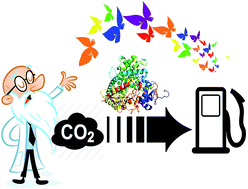A review of harvesting clean fuels from enzymatic CO2 reduction
Abstract
Rapid climate change and increase in the demand for hydrocarbon fuels have made the research community to recheck the carbon dioxide (CO2) concentration and its utilization in a green and efficient way. One of the best ways to utilize CO2 so far considered is its conversion back into fuels using various strategies such as thermal, photochemical, electrochemical and enzymatic. In this critical review the concepts and mechanism of CO2 reducing biocatalysts have been summarized. Specifically, more emphasis was given to enzymes related to the selective conversion of CO2 to fuels (popularly known as artificial photosynthesis). Emphasis has been given to single enzyme and multi-enzymatic systems for CO2 conversion to carbon monoxide, methanol, and formic acid/formate. Semiconducting nano-material integrated enzymatic systems and their mechanism are reviewed and described in detail. Finally, the ultimate challenges underlying the design of next generation enzymatic catalysts are explored.


 Please wait while we load your content...
Please wait while we load your content...